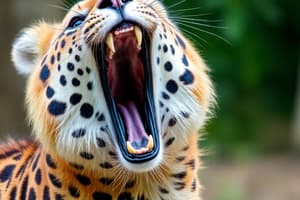Podcast
Questions and Answers
Which of the following best describes the relationship between genes and environment in shaping behavioral phenotypes?
Which of the following best describes the relationship between genes and environment in shaping behavioral phenotypes?
- Genes and environment act independently and do not influence each other.
- Behavioral phenotypes result from the interaction between genes and environment (P = G x E). (correct)
- Behavioral phenotypes are solely determined by genes.
- Behavioral phenotypes are solely determined by the environment.
Considering the 'four questions' of ethology, which of the following integrates proximate and ultimate causes to fully understand animal behavior?
Considering the 'four questions' of ethology, which of the following integrates proximate and ultimate causes to fully understand animal behavior?
- Focusing solely on the mechanism of the behavior.
- Integrating mechanism, ontogeny, phylogeny, and adaptive significance. (correct)
- Examining only the ontogeny, or development, of the behavior.
- Separating phylogeny from adaptive significance in analysis.
Studies of mechanism alone can definitively determine the ontogeny of a behavior.
Studies of mechanism alone can definitively determine the ontogeny of a behavior.
False (B)
If research indicates that a behavior is conserved across the carnivore evolutionary tree, which of the 'four questions' of ethology is primarily being addressed?
If research indicates that a behavior is conserved across the carnivore evolutionary tree, which of the 'four questions' of ethology is primarily being addressed?
In animal behavior studies, what qualities are usually measured to understand the dimension of a behavior?
In animal behavior studies, what qualities are usually measured to understand the dimension of a behavior?
A study that manipulates variables but cannot completely control them is referred to as ______.
A study that manipulates variables but cannot completely control them is referred to as ______.
Match the following research examples with the ethological question they primarily address:
Match the following research examples with the ethological question they primarily address:
A researcher is studying the impact of weather on horse behavior but cannot control the weather conditions. Which type of study is this?
A researcher is studying the impact of weather on horse behavior but cannot control the weather conditions. Which type of study is this?
Success in social integration is negatively correlated with foaling success.
Success in social integration is negatively correlated with foaling success.
Ethological knowledge, such as understanding behavioral dimensions and questions, is primarily assessed in what context?
Ethological knowledge, such as understanding behavioral dimensions and questions, is primarily assessed in what context?
Flashcards
P = G x E
P = G x E
Behavioral phenotypes result from the interaction between genes and environment.
Animal behavior explanations
Animal behavior explanations
Proximate causes focus on mechanism and ontogeny, while ultimate causes explore phylogeny and adaptive significance.
Scientific study of animal behavior
Scientific study of animal behavior
The study of animal behavior integrates multiple biological fields to deeply understand the 'whys' behind animal actions.
Ontogeny
Ontogeny
Signup and view all the flashcards
Phylogeny's Focus
Phylogeny's Focus
Signup and view all the flashcards
Adaptive Significance
Adaptive Significance
Signup and view all the flashcards
Dimensions of behavior
Dimensions of behavior
Signup and view all the flashcards
Ethogram
Ethogram
Signup and view all the flashcards
Types of Study Methods
Types of Study Methods
Signup and view all the flashcards
Study Notes
- This is a conceptual framework for studying animal behavior and understanding why animals do what they do.
- This framework is applicable to any species and any behavior.
- This framework works for normal and abnormal behavior and it works for managed and wild animals.
- This framework is rooted in animal behavior science, emphasizing its place as a branch of biology.
Themes
- Behavioral phenotypes result from the interaction between genes and environment (P = G x E).
- Animal behavior can be explained by proximate (mechanism, ontogeny) and ultimate causes (phylogeny, adaptive significance).
- These causes integrate, enabling a complete understanding of animal actions.
- Animal behavior's scientific study comes from many fields of biology, cutting across ethology's "4 questions," facilitating understanding of "whys."
Seal Mother Pup Example
- Seal mothers remain close to their pups because of ontogeny, mechanism, phylogeny, and adaptive significance
Applying the Conceptual Framework
- Applying this framework to managing animal behavior.
- Assessing learning of these concepts and associated skills as a solid foundation for building upon.
- The importance of understanding behavior to improve animal care and management as animal managers.
- This understanding comes from the process of science.
Using Science to Understand Animal Behavior
- Use science in animal behavior at a professional level.
- Identify primary literature and know where to find it.
- Approach a paper purposefully to grasp key ideas at scientific understanding level from any behavior paper.
- Communicate key ideas to someone who has not read the paper and use pre-recorded lectures posted in Brightspace for refreshers.
- Identify the 4 questions being addressed by a research project to know what the 4 questions including what types of questions they ask.
- Knowing "why" or "how" helps identify addressed questions.
- Determine if research asks a proximate question (why is animal doing behavior at this time) or an ultimate/evolutionary question (how/why is behavior the way it is in this species).
- Studies could address more than one element.
Confusion with Ontogeny
- If ontogeny is being studied, research must measure behavior at different time points in individual, or different age classes using young, juvenile, and adult animals.
- Additionally, measurements should be taken before, during, and after training.
- Mechanism studies can yield ontogeny hypotheses.
- Observations are needed through the relevant time points for various species.
Confusion with Phylogeny
- Consider where trait came from on evolutionary time scales.
- Comparing mechanisms in different dog breeds secondarily talks phylogeny of behavior.
- Adaptive significance measures survival, health, and reproduction.
Examples of Adaptive Significance
- Includes body condition, disease prevalence, litter size, offspring mass, and offspring survival.
Understanding Behaviour
- Identify dimension(s) of behavior being measured including quality (description), frequency (count, duration, etc.), or sequence (transitions between behaviors, expressed as a % or proportion).
- Identify the ethogram and study methods including observational, experimental, and quasi-experimental methods.
Real Quick Dive into a Paper
- To quickly dive into a paper, pick one or more papers Wolves and Dogs, Pig Gait, Pig Nursing, or Flamingos.
- Quickly identify the "why" question that is being asked and attempt to identify which of the 4 questions is explored by your paper.
Research Papers Discussion
- For each paper, identify the type of study (observational, experimental, quasi-experimental) and where the ethogram is defined, including which behaviors are important to the study.
- Identify what dimension(s) of behaviors were relevant to the hypothesis (quality, frequency, sequence).
- Identify which of the 4 questions is being addressed and explain why the dimension related to hypothesis.
Examples Study Methods
- Horses: quasi-experimental, frequency, mechanism, and ontogeny.
- Cats hunting: observational, frequency, and adaptive significance.
- Birds: quasi-experimental, frequency, and adaptive significance.
- Pandas: observational and experimental, quality and frequency, and adaptive significance.
Research Transfer
- Research fits with other research to explain why animals do what they do, and behavior research is integrative as behavior is affected by genetic and environmental factors.
- Determine how applicable the research to management situation and how the behavior research works.
- Understanding ethological concepts is relevant to careers in animal science, which enables usage of knowledge.
Exam #1 Breakdown
- There is a timed exam, (75 min).
- The exam assesses the subject's ability to think on your feet, which is of course important in animal management.
- The exam covers conceptual questions using the context of a paper provided.
- Open ended questions will demonstrate conceptual question understanding.
- Read paper first prior to answering questions.
Grey Seals Study
- "This graph shows that social integration score is positively correlated with foaling success"-Mares who spent more time socializing with other mares in a group were more likely to give birth than mares who were less social.
The exam will be ~10% of grade, and less than the points that you earn for being engaged in class (55 points so far).
- Check on skills and knowledge as we move into the more applied aspects of animal behavior.
Grey Seal Pups
- Dispersal of grey seal pups in Norway has individual variation.
- If pups swim, there is a risk of losing mother, freezing, and exhaustion.
Studying That Suits You
Use AI to generate personalized quizzes and flashcards to suit your learning preferences.





